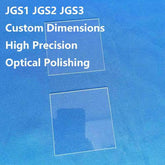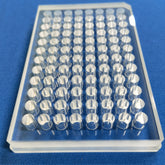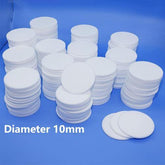Technical parameters and cleaning methods of laboratory quartz cuvettes
The quartz cuvette is utilized for loading reference and sample liquids, and it is paired with spectral analysis instruments to perform quantitative and qualitative analysis of substances. It finds extensive applications in the chemical industry, metallurgy, medical treatment, pharmacy, food production, environmental protection, power plants, water treatment, petroleum industry as well as scientific research institutions and universities. The glass cuvette can be categorized into three series based on its applicable wavelength: visible light series (referred to as glass cuvettes), ultraviolet-visible light series (known as quartz cuvettes), and infrared light series (referred to as infrared cuvettes).
Technical parameters of quartz cuvettes
(1) The transmittance of the quartz cuvette at 0.2, 0.25 and 0.3 microns is not less than 70%, 80% and 85%, respectively.
(2) The difference in transmittance between two quartz cuvettes of one set at the aforementioned three distances shall not exceed 0.5%.
(3) Quartz cuvettes have demonstrated no leakage or spalling after 24 hours of immersion in a range of substances, including 6 g hydrochloric acid, 6 g sodium hydroxide, alcohol with a purity under 98%, carbon tetroxide and benzene.
(4) The hermetic quartz cuvette has good sealing performance and is suitable for holding volatile solutions.
(5) The fluorescent quartz cuvette has four transparent sides, which is suitable for fluorescence analysis.

Classification of quartz cuvettes
- According to transmitting-light sides: quartz cuvettes with two sides transmitting light/ four sides transmitting light
- According to colors of cuvettes: black shell cuvettes/ white shell cuvettes
- According to the stoppers: quartz cuvettes withstoppers/ without stoppers
- According to the lids: quartz cuvettes with lids/ without lids

Cleaning method of quartz cuvettes
- The quartz cuvettes generally used on the market are fired by quartz powder, which should be cleaned by special ultrasoniccleaning with frosted surfaces facing downwards during the washing.
- Wash cuvettes with a mixture of ethyl ether and anhydrous ethanol (50% each). If the cuvette is too dirty, it can be cleaned with special washing solutions with short time (10 minutes), and then rinsed by clean water.
- Don't wash cuvettes with detergents like dish soap to avoid affecting the measurement.
Cleaning precautions
The cuvette is typically a cuboid, with its bottom surface and two lateral surfaces comprising frosted glass, and the remaining two lateral surfaces consisting of transparent optical glass produced by sintering and gluing quartz powder at high temperatures. It is therefore important to note the following points when using the cuvette:
- When taking the cuvette, it is imperative that only the frosted glass on both sides is touched, in order to avoid any contact with the optical surface. Additionally, it is imperative to handle the cuvette with care to avoid any external forces that could potentially exert damage.

- Solutions containing substances that corrode glass shall not be kept in a cuvettefor a long time.
- It is inadvisable to heat the cuvette over theflame or electric oven, or to subject it to the drying oven.
- In the event of contamination of the cuvette, it should be cleaned with anhydrous ethanol and wiped in a timely manner.
- Ensure that the transparent surface of the cuvette is not in contact with hard or soiled objects. When containing the solution, maintain a liquid height at 2/3 of the cuvette's capacity. If there is residual liquid on the optical surface, gently absorb it using filter paper and then wipe it with lens paper or silk.







1 comment
I would love to see more content from yourside.
Keep posting in future too.
Thanks for sharing.